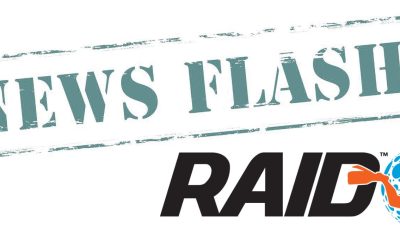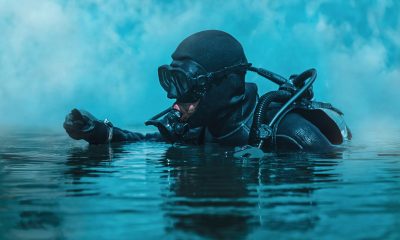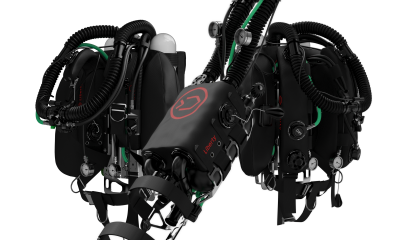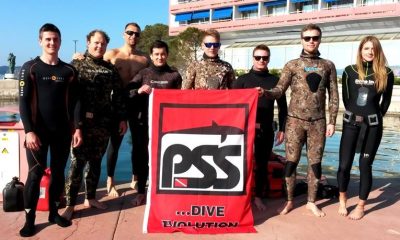News
Jill Heinerth and Steve Lewis join RAID

RAID has announced that Steve Lewis and Jill Heinerth have committed to producing cavern and cave programs for the diver training agency which are set for release in late 2016 / early 2017.
Training Director Paul Toomer had this to say: “I cannot believe that RAID has attracted two of the most influential divers in the world today. I have been friends with Steve and Jill for quite a few years but I could only dream of being able to entice two instructors of this caliber to our ‘little’ agency. I think the cave world will be stunned by what Steve and Jill are producing. The program promises to be extremely cutting edge and forward thinking. Steve, Jill and RAID are planning a full range of periphery materials like videos, cue cards, slates etc., and also a full range of marketing materials.
“Just 10 years ago I was watching Steve and Jill dive and teach cave and now here we are working together. All I can say is, get ready for some serious cave action.”
Steve Lewis had this to say about the new partnership: “It’s a terrific pleasure for me to work with RAID, Paul and Jill on this project. They have both my respect and admiration, and I’m blessed to be given this opportunity to help with the development of RAID’s overhead program, which all three of us see as more than just another agency throwing its hat into the cave/wreck penetration market. Rather we feel we have raised the bar and produced an instructor and diver program that will help future cave divers enjoy their diving, respect and protect the environment, and develop lifelong skills to keep them from becoming statistics.”
Steve Lewis is a technical diving instructor trainer, prolific author, and an adventure travel, marketing, and training consultant for various clients in the public and private sectors. He is an avid cave diver, but also has a particular interest in WWII shipwrecks.
Lewis was elected to The Explorers Club in May 2005 for his exploration of deep wrecks in North America’s Great Lakes, and is a member of the College of Fellows of the Royal Canadian Geographical Society (RCGS). He is also a recipient of the Sheck Exley International Safety Award. He has been a member of several expeditions, and in 2007 led a team that assessed the Bell Island iron ore mine for “condition, safety and feasibility” of future research.
Their report provided the Bell Island Heritage Society with important information on artifacts left when mining operations ended in the 1940s. In 2016, he was part of the team that successfully revisited the mine to continue the work begun nine years before. This recent project carried flags from the Explorers Club and RCGS, and was voted project of the year by the RCGS.
He has published dozens of articles about diving and diver training for various publications and has written several textbooks and instructor guides. He is a popular speaker and has made presentations focused on diver safety at many dive shows and seminars. His published books on diving include: The Six Skills and Other Discussions, a guide for technical divers and the very popular Staying Alive: Applying Risk Management to Advanced Scuba Diving.
On joining the RAID cave team, Jill had this to say: “It is a pleasure to work with Steve Lewis and RAID who are building a truly objective cave training program with very clear and demanding standards. The RAID program will permit students, instructors and trainers to know precisely what is expected in training while the quality assurance program will ensure a high bar for maintaining excellence and preventing attrition of knowledge. Steve Lewis brings a wealth of experience and wisdom to writing excellent materials that will benefit students as they prepare themselves for class.”
A pioneering underwater explorer and filmmaker, Jill’s photography and writing have been featured in prominent publications around the world. In recognition of her lifetime achievement, Jill was awarded the inaugural Medal for Exploration by the Royal Canadian Geographical Society and was appointed as their first Explorer in Residence. Recognizing a lifetime devoted to water advocacy, Jill was also awarded the Wyland Icon and Sea Hero of the Year awards. Jill is a motivational speaker, prolific author of numerous books on technical diving and pioneer in the field of technical rebreather and cave diving. She founded www.WeAreWaterProject.com to spread water literacy and information that helps people to become better stewards of our water resources.
Jill wrote, produced, and starred in the PBS Documentary series “Water’s Journey,” and has numerous National Geographic and NOAA expeditions and film projects on her resume. Jill is a monthly columnist for Diver Magazine, and her articles and photos have appeared in publications as diverse as National Geographic and the Wall Street Journal. She is a Fellow of the National Speleological Society, The Explorer’s Club, Women Divers Hall of Fame and the Royal Canadian Geographical Society. Jill is an international speaker who has spoken at prestigious events such as TED as well as diving shows from Singapore to Poland and all over North America.
To find out more about RAID, visit www.diveraid.com.
Blogs
Northern Red Sea Reefs and Wrecks Trip Report, Part 2: Wall to Wall Wrecks

Jake Davies boards Ghazala Explorer for an unforgettable Red Sea diving experience…
The second day’s diving was a day full of wreck diving at Abu Nuhas, which included the Chrisoula K, Carnatic, and Ghiannis D. The first dive of the day was onto the Chrisoula K, also known as the wreck of tiles. The 98m vessel remains largely intact where she was loaded with tiles which can be seen throughout the hold. The stern sits at 26m and the bow just below the surface. One of the highlights of the wreck is heading inside and seeing the workroom where the machinery used for cutting the tiles are perfectly intact. The bow provided some relaxing scenery as the bright sunlight highlighted the colours of the soft coral reef and the many reef fish.

Following breakfast, we then headed to the next wreck, which was the Carnatic. The Carnatic is an 89.9m sail steamer vessel that was built in Britain back in 1862. She ran aground on the reef back in 1869 and remains at 27m. At the time, she was carrying a range of items, including 40,000 sterling in gold. An impressive wreck where much of the superstructure remains, and the two large masts lay on the seafloor. The wooden ribs of the hull provide structures for lots of soft corals, and into the stern section, the light beams through, bouncing off the large shoals of glass fish that can be found using the structure as shelter from the larger predators that are found outside of the wreck.

The final wreck at Abu Nuhas was the Ghiannis D, originally called ‘Shoyo Maru,’ which was 99.5m long and built in Japan back in 1969 before becoming a Greek-registered cargo ship in 1980. The ship then ran aground on the reef on April 19th, 1983, and now sits at the bottom at a depth of 27m. Heading down the line, the stern of the ship remains in good condition compared to the rest of the hull. The highlight of the wreck, though, is heading into the stern section and down the flights of stairs to enter the engine room, which remains in good condition and is definitely worth exploring. After exploring the interior section of the ship, we then headed over to see the rest of the superstructure, where it’s particularly interesting to see the large table corals that have grown at the bow relatively quickly considering the date the ship sank. After surfacing and enjoying some afternoon snacks, we made sure everything was strapped down and secured as we would be heading north and crossing the Gulf of Suez, where the winds were still creating plenty of chop.

The next morning, it was a short hop to Ras Mohammed Nature Reserve for the next couple of days of diving. The 6am wake-up call came along with the briefing for the first site we would be diving, which was Shark & Yolanda. The low current conditions allowed us to start the dive at Anemone City, where we would drift along the steep, coral-filled wall. These dives involved drifts, as mooring in Ras Mohammed wasn’t allowed to protect the reefs. As a dive site, Shark & Yolanda is well-known and historically had a lot of sharks, but unfortunately not so many in recent years, especially not so early in the season. However, there was always a chance when looking out into the blue.

The gentle drift took us along the steep walls of the site, with plenty of anemone fish to be seen and a huge variety of corals. It wasn’t long into the dive before we were accompanied by a hawksbill turtle, who drifted with us between the two atolls before parting ways. Between the two reefs, the shallow patch with parts of coral heads surrounded by sand provided the chance to see a few blue-spotted stingrays that were mainly resting underneath the corals and are always a pleasure to see. With this being the morning dive, the early sunlight lit up the walls, providing tranquil moments. Looking out into the blue, there was very little to be seen, but a small shoal of batfish shimmering underneath the sunlight was a moment to capture as we watched them swim by as they watched us.

Towards the end of the dive, we stopped at the wreck of the Jolanda where the seafloor was scattered with toilets from the containers it was carrying. This provided a unique site to make a safety stop, which was also accompanied by a large barracuda slowly swimming by, along with a hawksbill turtle calmly swimming over the reef as the sun rays danced in the distance.
For the next dive, we headed north to the Strait of Tiran to explore the reefs situated between Tiran Island and Sharm El Sheik, which were named after the British divers who had found them. We started on Jackson before heading to Gordons Reef, where we also did the night dive. All the atolls at these sites provided stunning, bustling coral reefs close to the surface and steep walls to swim along, which always provided the opportunity to keep an eye out for some of the larger species that can be seen in the blue. Midwater around Jackson Reef was filled with red-toothed triggerfish and shoals of banner fish, which at times were so dense that you couldn’t see into the blue. Moments went by peacefully as we enjoyed the slow drift above the reef, watching these shoals swim around under the mid-afternoon sun.

The night dive at Gordon’s Reef was mainly among the stacks of corals surrounded by sand, which was great to explore under the darkness. After some time circling the corals, we came across what we were really hoping to find, and that was an octopus hunting on the reef. We spent the majority of the dive just watching it crawl among the reef, blending into its changing surroundings through changes in colour and skin texture. It’s always so fascinating and captivating to watch these incredibly intelligent animals, in awe of their ability to carry out these physical changes to perfectly blend into the reef. Before we knew it, it was time to head back to the boat to enjoy a well-deserved tasty dinner prepared by the talented chefs onboard.
Check in for the 3rd and final part of this series from Jake tomorrow!
To find out more about the Northern Red Sea reef and wrecks itineraries aboard Ghazala Explorer, or to book, contact Scuba Travel now:
Email: dive@scubatravel.com
Tel: +44 (0)1483 411590
Photos: Jake Davies / Avalon.Red
Marine Life & Conservation
Double Bubble for Basking Sharks

 The Shark Trust is excited to announce that, for two more days only, all donations, large or small, will be doubled in the Big Give Green Match Fund!
The Shark Trust is excited to announce that, for two more days only, all donations, large or small, will be doubled in the Big Give Green Match Fund!
Donate to Basking in Nature: Sighting Giants
The Shark Trust is hoping to raise £10k which will be doubled to £20k. This will go towards Basking in Nature: Sighting Giants. And they need YOUR help to reach they’re goal.
The Shark Trust’s citizen science project is to monitor and assess basking sharks through sightings; encouraging data collection, community engagement, and promoting nature accessibility. This initiative aims to enhance health and wellbeing by fostering a deeper connection with British Sharks.
Campaign Aims
- Increase citizen science reporting of Basking Sharks and other shark sightings to help inform shark and ray conservation.
- Provide educational talks about the diverse range of sharks and rays in British waters and accessible identification guides!
- Create engaging and fun information panels on how to ID the amazing sharks and rays we have on our doorstep! These can be used on coastal paths around the Southwest. With activities and information on how you can make a difference for sharks and rays!
- Promote mental wellbeing through increasing time in nature and discovering the wonders beneath the waves!
Donate, and double your impact. Click Here
-

 News3 months ago
News3 months agoHone your underwater photography skills with Alphamarine Photography at Red Sea Diving Safari in March
-

 News3 months ago
News3 months agoCapturing Critters in Lembeh Underwater Photography Workshop 2024: Event Roundup
-

 Marine Life & Conservation Blogs2 months ago
Marine Life & Conservation Blogs2 months agoCreature Feature: Swell Sharks
-

 Blogs2 months ago
Blogs2 months agoMurex Resorts: Passport to Paradise!
-

 Blogs2 months ago
Blogs2 months agoDiver Discovering Whale Skeletons Beneath Ice Judged World’s Best Underwater Photograph
-

 Gear Reviews2 months ago
Gear Reviews2 months agoGear Review: Oceanic+ Dive Housing for iPhone
-

 Marine Life & Conservation2 months ago
Marine Life & Conservation2 months agoSave the Manatee Club launches brand new webcams at Silver Springs State Park, Florida
-

 News3 months ago
News3 months agoWorld’s Best Underwater Photographers Unveil Breathtaking Images at World Shootout 2023



















